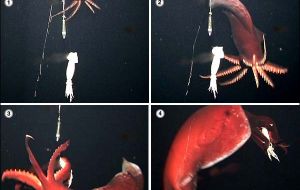MercoPress. South Atlantic News Agency
Deep sea giant squid flash blinding light to attack prey
 The squid in action: 1. The squid swims towards the bait; 2. It spreads its arms wide; 3. It swims around the bait, twisting its body; 4. It grabs the bait with its eight arms.
The squid in action: 1. The squid swims towards the bait; 2. It spreads its arms wide; 3. It swims around the bait, twisting its body; 4. It grabs the bait with its eight arms. Enormous deep-sea squid emit blinding flashes of light as they attack their prey, research shows. Taningia danae's spectacular light show was revealed in video footage taken in deep waters off Chichijima Island in the North Pacific and reported by BBC.
Japanese scientists believe the creatures use the bright flashes to disorientate potential victims. Writing in a Royal Society journal, they say the squid are far from the sluggish, inactive beasts once thought. In fact, the footage, taken in 2005 - the first time T. danae had been captured on camera in their natural environment - reveals them to be aggressive predators. The squid, which can measure over 2m (7ft) in length, deftly swim backwards and forwards by flapping their large, muscular fins. They are able to alter their direction rapidly by bending their flexible bodies. The films, taken at depths of 240m to 940m, also show the cephalopods reaching speeds of up to 2.5m per second as they attack the bait, capturing it with their eight tentacles. However, the intense pulses of light that accompanied the ferocious attacks surprised the research team. Dr Tsunemi Kubodera from the National Science Museum in Tokyo, who led the research, told the BBC News website: "No-one had ever seen such bioluminescence behavior during hunting of deep-sea large squid." The footage reveals the creatures emitting short flashes from light-producing organs, called photophores, on their arms. Writing in Proceedings of the Royal Society B, the team said: "The bioluminescence might act as a blinding flash for prey." The light would disorientate the squid's intended prey, disrupting their defenses, they added. It could also act, the scientists commented, "as a means of illumination and measuring target distance in an otherwise dark environment." However, further investigation revealed the light bursts may also serve another, quite different, purpose away from the hunting field - courtship. As the squid drifted around torches that had been attached to the bait rig, they emanated long and short pulses of light. The team believes the torch lights may have resembled another glowing T. danae, and the squid were possibly emitting light as courtship behavior. Deep-sea squid - once thought to be legendary monsters of the sea - are notoriously difficult to study, and little is known about their ecology and biology. Several species prowl the ocean depths. T. danae is thought to be abundant in the tropical and subtropical oceans of the world. The largest reported measured 2.3m in length and weighed nearly 61.4kg. Larger species of giant squid belong to the Architeuthidae family: females are thought to measure up to 13m in length. But the aptly named colossal squid (Mesonychoteuthis hamiltoni) is thought to be the largest of all - possibly reaching up to 14m long. (BBC).-




Top Comments
Disclaimer & comment rulesCommenting for this story is now closed.
If you have a Facebook account, become a fan and comment on our Facebook Page!